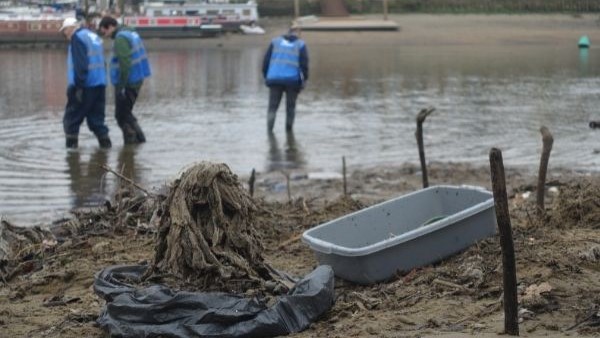Around 64,000 wet wipes have been counted and removed from several small sections of the Thames foreshore by volunteers over a period of five years, environmental charity Thames21 has announced.
Since 2017, Thames21 has partnered up with citizen scientists, the Port of London Authority (PLA) and Tideway, the company building London’s super sewer, to run its Big Wet Wipe Count event and gather crucial people-powered data on the wet wipes settling at sampling locations along the Thames to monitor the impact of plastic on the capital’s river and lobby for change.
Wet wipes enter the river through sewage pipes after they are flushed down toilets. Most contain plastic in them and because of this they can cause blockages which back up sewage that spills into the River Thames. When they end up on the foreshore, they eventually break down into microplastic and damage aquatic life and the Thames’ ecosystem.
Big Wet Wipe sampling locations include the foreshore near Hammersmith Bridge and Battersea Bridge.
Debbie Leach, CEO at Thames21, said:
“We are no longer shocked that we keep on pulling these wet wipes out of the Thames foreshore. However, the huge number our volunteers have pulled out over this five-year period is staggering and shows the urgency of the problem.
“Wet wipes made with plastic are contaminating our rivers. They are building up in large numbers on the River Thames foreshore, and the plastic is potentially devastating to wildlife in the river.
“The government concluded its consultation on single-use plastics in February 2022 and looked at the issue of banning plastic in wet wipes. We are looking forward to the results of this consultation, which is due out at the end of the year. Swift action is needed to put an end to this dreadful form of sewage-based pollution, which is doing great harm to the Thames.”
2021 saw volunteers pick up more than 27,000 wipes (a figure included in the 64,000 total) over the space of two days near Battersea Bridge.
At its most recent Big Wet Wipe Count event held at Hammersmith Bridge, more than 2,000 wet wipes were counted and removed from one section of the Thames foreshore in under two hours.
More than 50 citizen scientists took part in the event which saw the wet wipes, totalling 57 bin bags’ worth, removed from a 68 square metre area of foreshore near Hammersmith Bridge in Barnes.
Ten transects were laid out 25m apart running from the main foreshore wall down to the River Thames covering a 250m strip of foreshore. The transects were geolocated precisely by experts from the Port of London Authority. Citizen scientists were given specific areas to survey the litter within their allocated transects.
Last year, Thames21’s citizen scientists found almost 2,000 wet wipes in the same location, that’s 33 wet wipes on every m2 of the foreshore.
The data will be added to bathymetric (hydrographic) survey data held by the PLA which shows the change in mound height overtime allowing Thames21 and the PLA to assess whether the problem is getting better or worse and to analyse how the new Thames Tideway Tunnel (due to open in 2025) improves the situation.
John Sage, Tideway’s Head of Corporate Responsibility, said:
“Tideway is committed to cleaning up the River Thames by tackling the problem of sewage pollution. Research like this shows the scale of the problem, with many thousands of wet wipes embedded into a relatively small area of the Thames foreshore.
“We’re proud of our partnership with Thames21 and look forward to seeing the results of Tideway’s positive impact on the health of the River Thames in a few years’ time.”



